

Making Connections: PreK–12 OER in Practice. #GoOpen: More than a Hashtag – Office of Ed Tech – Medium. In October 2015, the U.S.
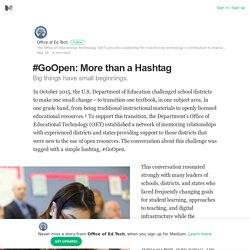
Department of Education challenged school districts to make one small change — to transition one textbook, in one subject area, in one grade band, from being traditional instructional materials to openly licensed educational resources.¹ To support this transition, the Department’s Office of Educational Technology (OET) established a network of mentoring relationships with experienced districts and states providing support to those districts that were new to the use of open resources. The conversation about this challenge was tagged with a simple hashtag, #GoOpen. This conversation resonated strongly with many leaders of schools, districts, and states who faced frequently changing goals for student learning, approaches to teaching, and digital infrastructure while the materials available to students and teachers were not keeping pace with those changes [See: Why Go Open, Why Now?].
Wide open future. Greatest lesson: Teacher buy-in is overrated. One of the greatest lessons my 30 years of experience in education has taught me is that teacher buy-in is, sometimes, overrated.
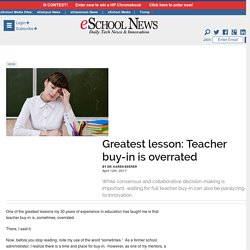
There, I said it. Now, before you stop reading, note my use of the word “sometimes.” As a former school administrator, I realize there is a time and place for buy-in. However, as one of my mentors, a seasoned middle school principal once explained to me, while consensus and collaborative decision-making is important, it can also be paralyzing to innovation. Understanding the balance between growing buy-in and launching innovation has never been more important than in today’s era. As new ideas about teaching and learning go in and out of style, teachers have a right to feel some initiative fatigue. #GoOpen District Launch Packet - Office of Educational Technology. Open The Future – Andrew P. Marcinek – Medium. It’s rather difficult these days not to trip over the word innovation within the educational ecosystem.
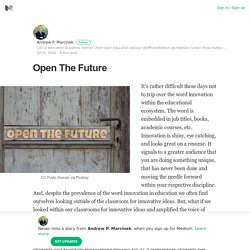
The word is embedded in job titles, books, academic courses, etc. Innovation is shiny, eye catching, and looks great on a resume. It signals to a greater audience that you are doing something unique, that has never been done and moving the needle forward within your respective discipline. And, despite the prevalence of the word innovation in education we often find ourselves looking outside of the classroom for innovative ideas. But, what if we looked within our classrooms for innovative ideas and amplified the voice of educators? Educators are some of the most innovative professionals in the country. However, we have an opportunity in P-12 education to change this process and nurture innovative practices within the classroom. *N.a. **N.a. The Lego Bin – Office of Ed Tech – Medium.
When I was a kid, my brother and I played with Legos quite frequently.
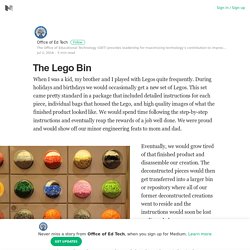
During holidays and birthdays we would occasionally get a new set of Legos. This set came pretty standard in a package that included detailed instructions for each piece, individual bags that housed the Lego, and high quality images of what the finished product looked like. We would spend time following the step-by-step instructions and eventually reap the rewards of a job well done. We were proud and would show off our minor engineering feats to mom and dad. Eventually, we would grow tired of that finished product and disassemble our creation. As young kids, we were excited to be guided through the entire Lego creation package, but we soon learned that the real magic lay in the repository of disassembled Lego pieces. And this was the problem. Twenty years later, I found myself perusing the aisles of IKEA admiring the staged rooms and taking notes on the items I desired. Then I found out about IKEA hacks.
Institutional OER Policy -Template. #GoOpen: Using Open Educational Resources to Develop Dynamic Digital Content for Classrooms. Successful OER Adoption Models: Academic Libraries Leading the Way - SPARC. Successful OER Adoption Models: Academic Libraries Leading the Way In celebration of Open Education Week 2017, SPARC is hosting an hour long webcast centred on the theme of successful OER adoption models.
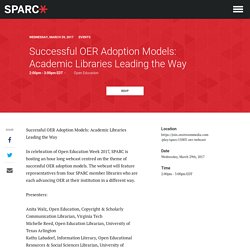
The webcast will feature representatives from four SPARC member libraries who are each advancing OER at their institution in a different way. Open Educational Resources ( OER ) - Go Open Regional Summit. Some Lessons Learned Supporting OER Adoption. The tl;dr: Supporting effective OER adoption at scale has its problems.Many of these problems have openly licensed solutions.Sometimes it makes sense to deploy these solutions yourself; sometimes it makes more sense to work with a partner.

Background and Some Problems To put it in a depressingly small nutshell, I spent the first decade or so of my career creating open licenses to make the sharing of OER legally possible, traveling the world talking to people about why they might want to place an open license on their educational materials and other creative works, experimenting with different open pedagogies in my own teaching, and conducting empirical research about the impacts of OER adoption on outcomes for students, faculty, and institutions. Over the last several years my fellow travelers at Lumen and I have learned a lot of painful lessons about supporting OER adoption among faculty.
And then there were the attribution problems. Feel like hitting your head against a brick wall yet?